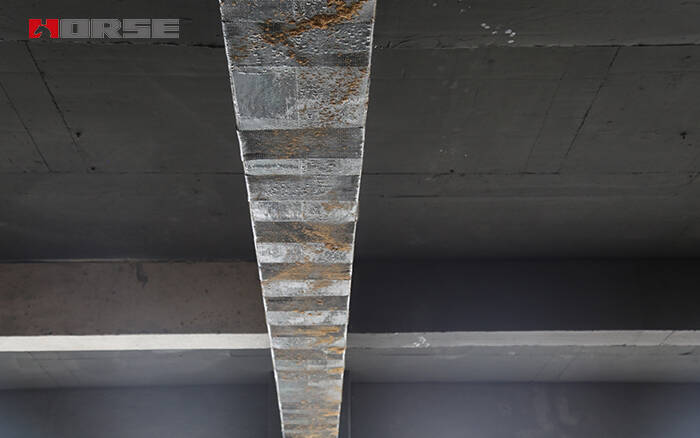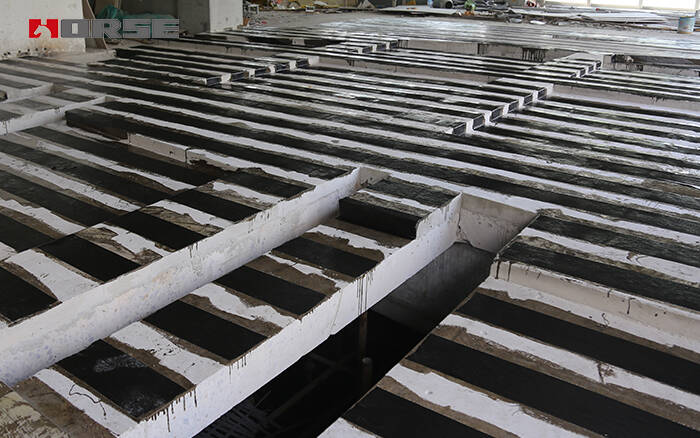Solutions
Horse Construction offers full range of structural strengthening materials with technical supports, documentation supports, products supports, project supports.
Why is FRP Used for Structural Strengthening?(2)

The most recent article mainly talks about FRP repair and reinforcement of concrete structures, today’s article, we continue to talk about the FRP construction process and key factors.
https://www.horseen.com/index/solution/content/id/993
External reinforcement
The external paste reinforcement method has specific regulations on construction in (CECS 146: 2003), (GB 50550-2010), (GB 50608-2010) and other specifications.
The construction process of the external sticking reinforcement method is generally: construction preparation→concrete surface treatment→preparation and application of primer→preparation of repair glue and filling and repairing treatment of uneven concrete surface→preparation and application of structural adhesive→adhesive carbon fiber sheet →Surface protection.
In the construction of the external paste reinforcement method, the key points of the construction are controlled. In the treatment of the base layer, the concrete cracks with a joint width greater than or equal to 0.15mm in the reinforcement range should be repaired in accordance with the design requirements, removing the loose concrete from the surface to a solid layer. Remove the rust on the surface of the exposed steel bars to reveal the metallic luster. According to the design requirements, use concrete or epoxy mortar or epoxy fine stone concrete higher than the original structure to repair the base concrete problem to the original structure surface. When the primer is painted, it is required to repeatedly paint in the vertical and horizontal directions, forward and reverse so that the primer can better penetrate into the concrete surface. When sticking the fiber cloth, use a special roller to roll in the direction of the fiber many times to squeeze out the bubbles, so that the glue can fully penetrate the carbon fiber cloth.
Embedded reinforcement method
The construction process of embedded reinforcement is generally: groove the structure surface according to the design size → clean the ash in the groove → inject resin into the groove to about 1/2 height → implant the FRP material into the groove and press it gently → toward the groove Inject resin into the tank to be filled with resin → surface treatment after the resin is cured.
It is necessary to pay attention to the problems of slotting, material selection and speed in the construction of embedded reinforcement. In the process of grooving in accordance with the design requirements, it will cause damage to the original structure. In order to reduce the damage to the structure, the direction and size of the groove should be strictly in accordance with the design requirements. The depth of the groove should consider the size of the material used and the concrete protective layer. The thickness is slightly larger than the size of the reinforced FRP material. In the selection of bonding materials, high thixotropic resins are usually used to make the construction easier. At the same time, the fluidity of the resin is not easy to be too strong, otherwise it is not conducive to construction under the environment of looking up. In the actual construction process, cement slurry can be used instead of resin, but the former requires dry contact surface and the latter requires wet contact surface. In the process of inserting the reinforcing material, pay attention to gently pressing the material into the resin, maintaining a certain speed, avoiding air bubbles on the surface of the material, so that the surface is filled with resin, which is beneficial to the bonding of the FRP material and the original structure. The entire process of embedding reinforcement materials, from mixing glue to smoothing, should be carried out according to the curing time of the resin to avoid the hardening of the resin and affect the quality of the embedding construction.
Prestressed reinforcement method
In (GB 50367-2013), there are regulations on the design method and construction requirements of prestressed carbon fiber board reinforcement.
At present, the prestressed reinforcement technology is mainly the reinforcement technology of prestressed carbon fiber cloth and prestressed carbon fiber board. The construction of prestressed reinforcement technology mainly includes four processes, namely surface treatment, tensioning, pasting, and tensioning.
Prestressed carbon fiber cloth construction technology is a highly comprehensive technology, and the reinforcement effect is greatly affected by the proficiency of on-site workers. The following content needs to be controlled during the construction process. The tensioning device must be firmly fixed, and generally use planting bars or anchor bolts to fix the equipment on the member to be reinforced. Pay attention to controlling the tensioning speed when applying prestress, and use a reasonable tensioning speed to obtain the ideal prestress level. When unwinding, pay attention to cutting the carbon fiber cloth at both ends and try to synchronize as much as possible. When pasting multiple layers of carbon fiber cloth, it is necessary to wait until the surface of the impregnated resin of the previous layer is dry to the touch before proceeding to the next process. In the construction technology of prestressed carbon fiber board, at least one end of the tension end and the anchor end of the anchorage required to be anchored is a free movable end. When the tensioning process is smooth and the design stress is reached, the tensioning device is released, the adhesive is applied, and then tensioned to the design stress value twice.
Grid/grid reinforcement
The construction process of FRP grid reinforcement is generally: material selection (FRP grid and polymer cement mortar) → concrete base treatment → FRP grid installation → polymer cement mortar preparation → spraying polymer cement mortar → curing.
In the construction process, attention should be paid to the control of key links, which are divided into two aspects: materials and construction. First, in terms of materials, the thickness of the material and the size of the grid should be selected according to actual needs. The polymer cement mortar must have sufficient bonding strength to ensure reliable bonding with the original concrete. The polymer cement mortar must be able to coordinate with the original concrete deformation, and meet the fatigue performance and durability performance under the action of the dynamic load required by the structure. Pay attention to the preparation of cement mortar in strict accordance with the proportion and the order of feeding. Second, during the construction process, attention should be paid to the use of anchors and the overlap of the grid materials during the installation of the FRP grid. Use anchors to fix the mesh material on the concrete surface to avoid gaps, and use rubber pads to protect the fiber mesh from damage when tightening the anchors. During the lap joint, the specified lap length must be met, and the two ends of the lap section should be fixed firmly with anchor nails to prevent the lap part from becoming a weak part. When spraying polymer cement mortar, it is difficult to fill some intersections and there will be gaps when using spray construction. At this time, use a trowel to fill and compact the gaps in the grid.
Restraint reinforcement
The restraint reinforcement method has relevant design regulations in (GB 50702-2011) and (GB 50367-2013).
The construction process of restraint reinforcement is generally: preparation work → basic treatment work (remove damage and deterioration of concrete, remove rust from steel bars, repair cracks, flatten the surface, and polish the corners into an arc) → apply base resin → apply impregnating resin → Paste carbon fiber cloth → surface finishing work.
During construction, attention should be paid to the material selection width not to be too large to avoid wrinkles when pasting. In the surface treatment, the rectangular cross-section column is chamfered and polished into the arc shape specified by the design, and polished smoothly. When the concrete is uneven, levelling materials should be used to fill and level the problematic parts. After applying the primer, use resin putty to level it carefully to avoid wrinkles when applying the cloth. The process of winding and pasting the fiber cloth is required to be smooth and straight, without wrinkles and positional deviation. Use a roller to roll and squeeze the air bubbles along the fiber direction of the fiber cloth multiple times to ensure that the concrete surface and the fiber cloth are closely adhered. Before the next layer is applied, apply the impregnating resin on the previous surface, and then apply the cloth according to the above construction process. After the last layer is applied, apply a layer of adhesive on the surface, and then cover it with a film cloth for curing.

Conclusion
This article analyzes the characteristics, construction process, standards and specifications of the current common FRP application methods for repairing and strengthening concrete structures, and summarizes the following points:
1. At present, the application of FRP reinforcement technology is single, mainly using external paste reinforcement method, and other methods are rarely used. Therefore, it is necessary to promote the use of more effective reinforcement technology in engineering applications, improve the comprehensive ability of construction workers, and better utilize the advantages of FRP materials.
2. Although the method of FRP strengthening concrete structure is relatively complete in theory, most of the research is still limited to research, and further research is required for the specific regulations in standards and specifications. For example, FRP application-related design codes are limited to externally attached reinforcement methods and restraint reinforcement methods. In terms of prestressed FRP reinforcement technology, currently only the "Code for Design of Reinforcement of Concrete Structures" (GB 50367-2013) involves the reinforcement technology of prestressed carbon fiber boards. At the same time, the corresponding construction technology and inspection and acceptance standards and specifications also urgently need to be released in time after the relevant design standards are issued to meet the application of engineering construction.
3. FRP technology is developing rapidly, but the process of standardizing these technologies is lagging behind, requiring more construction and scientific research personnel to invest in the standard formulation process to contribute to the development of FRP application reinforcement technology.
4. The technology of FRP repairing and strengthening concrete structures is still developing. With the deepening of research on FRP materials and reinforcement technology, methods for prestressed FRP reinforcement concrete structures and prestressed FRP reinforcement embedded reinforcement concrete structures will gradually mature.
You can find anything here you are in need of, have a trust trying on these products, you will find the big difference after that.

High strength carbon fiber reinforced polymer (CFRP) strip / laminate / plate for structural strengthening and concrete repair

Prestressed carbon fiber reinforced polymer(CFRP) plate for slab, beam strengthening to increase stiffness, reduce distortion and deflection of members, reduce the cracks, avoid and stop cracking.

High strength, unidirectional carbon fiber fabric pre-saturated to form a carbon fiber reinforced polymer (CFRP) fabric used to strengthen structural concrete elements.